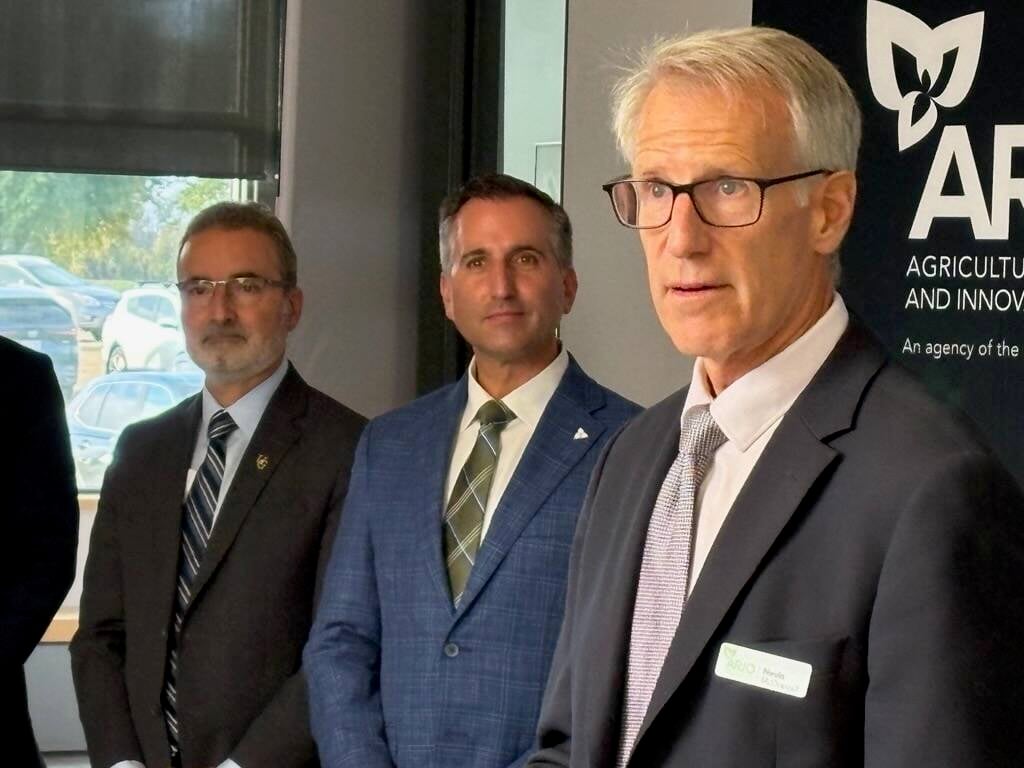Residents of rural Ontario are creating new energy efficient solutions, whether or not government is involved.
Farmers, rural residents and planners talked about rural environmental sustainability at the recent Rural Talks to Rural (R2R) Conference put on by the Centre for Rural Creativity in Blyth.
At Rob McKinlay’s farm in Oxford County, his small 20 kilowatt (kw) biogas digester is replacing about the same amount of energy used on the farm — about 15 kw average.
When Chris Lee decided to build a new house on his rural property near Walton, Ont., he decided to build a passive house, that focuses on minimal energy use for little more cost and more money going into the local economy.
Read Also

OMAFA research funding includes boost for poultry centre
OMAFA announced $41 million in funding for Agriculture Research and Innovation Ontario’s infrastructure on Oct. 7, including new funds for the Poultry Research Centre at the Elora Research Station.
In Woodstock, a social housing development is being constructed so that heating costs to residents will be about $45 per year.
Why it matters: Many rural businesses don’t make decisions based on energy efficiency, although it is making more sense as energy costs rise.
“Effectively we are off grid,” said McKinlay. “We take advantage of the framework in Ontario to balance load throughout the day,” he said.
The load is balanced through both a Feed In Tariff (FIT) and MicroFIT contract. The contracts mean he can buy electricity for 18 cents per kilowatt hour and sell it for 25 cents per kilowatt hour. He said payback for the investment will take about 10 years based on future energy price projections.
“That’s darned good for any equipment you’re going to put on a farm.”
The new Conservative government cancelled the MicroFIT program and McKinlay said that he’s curious to see how net metering, the ability to put excess energy production back into the grid, will develop. The cancellation of the Green Energy Act has put some of the next projects for Biolectric, the Belgian company that supplied the anaerobic digestion system for McKinlay’s farm, in jeopardy, said McKinlay.
There are already 42 anaerobic digestion systems running in Ontario, most of them larger than McKinlay’s and using waste vegetative matter in their systems. McKinlay only uses the manure from his farm.
He said he wished he could sell his electricity to his neighbours, but the system has not got to that point yet.
David Mayberry, warden of Oxford County was also on the panel at the R2R conference. He said there are limits in the electricity system that preclude community energy-sharing systems. There’s a need for longer-term thinking, he said.
“As a farmer, when you buy a farm, it is a long-term investment. You’ll be paying for it for a long time, and your children might be as well,” he said. Businesses think in less than five-year paybacks, but it can take 15 years for alternative energy projects to show return.
The Blossom Park social housing development in Woodstock, will take longer to pay back, he said, but operating costs are much lower than traditional buildings.
McKinlay said there’s a lot of interest in practical alternative energy among farmers.
“Farmers are independently minded people. There’s something romantic about being self-sufficient and off the grid, so it’s going to take off. I’m hopeful,” said McKinlay.
Lee, who developed a motosport park on a good portion of his 200-acre property, looked to build a new home on his property and the more he investigated, the more he came to believe in building a certified passive home.
Lee said that reducing spending on energy provided by large utilities means more money in the local community down the road. He expected to spend about $700 in energy per year in his new home, compared to $7,000 in the 125-year-old farmhouse where he used to live.
When his energy use is that low, he could now consider solar or wind power and be off the grid.
He said if more people saved money by considering energy efficiency when building, that money would be spent in the local community.
Lee had to import parts of his house because they weren’t made in Ontario, or even North America. His tripled-glaze, triple-gasketed windows had to come from Europe.
“Those windows should be built in Ontario or in Huron County,” he said.
“There are so many things we can do but just stopping and thinking about them,” said Lee. “It’s just about making a choice. We’re not paying a premium to do something.”
Indwell is the company building the Blossom Park development in Woodstock.
Graham Cubitt of Indwell said that buildings need to be rethought for such energy efficiency. That challenges some people who have been used to building in certain ways.
Cubitt, whose company works in cities and rural areas, said there are advantages to being in rural Ontario. “You can make changes quickly. Rural Ontario has a huge advantage over urban Ontario.”
















